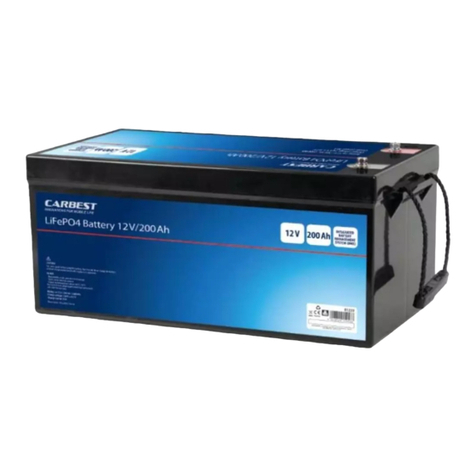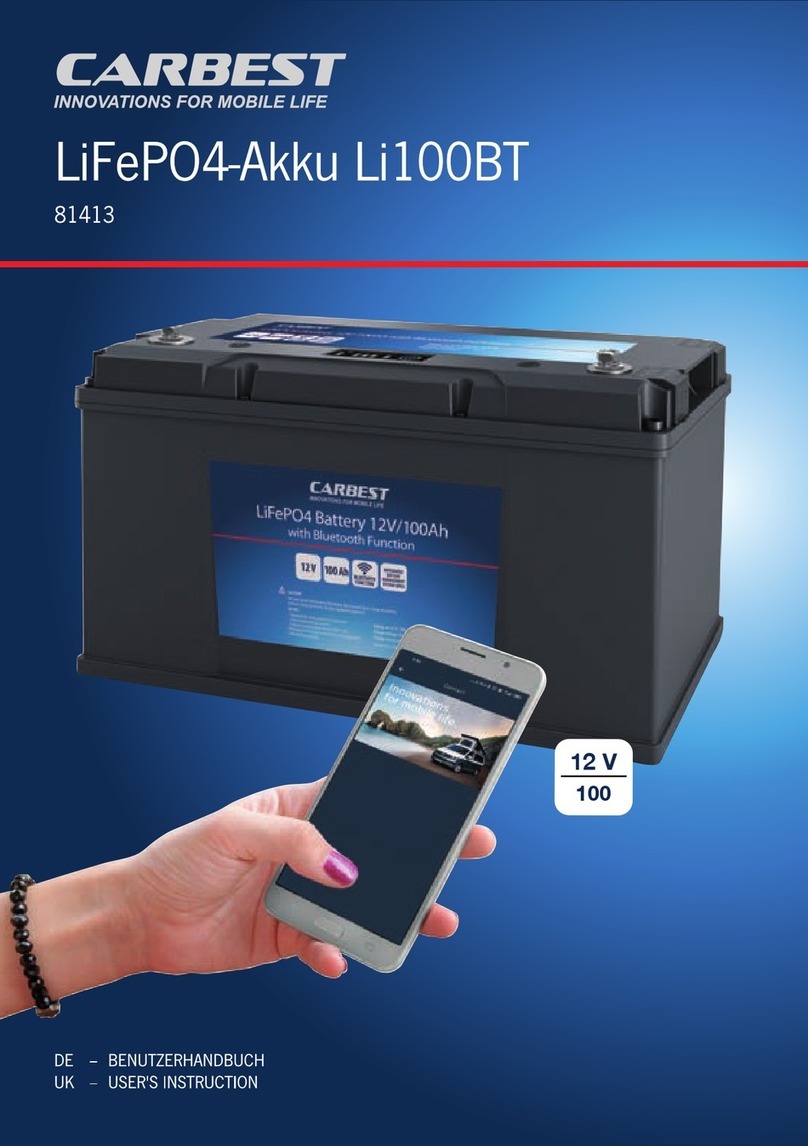
6 7
CARBEST | LiFePO4 Akku | 81451 / 81452 / 81453 CARBEST | LiFePO4 Akku | 81451 / 81452 / 81453
DE
EN
IT
ES
FR
NL
FI
DK
SE
DE
EN
IT
ES
FR
NL
FI
DK
SE
4. EINFÜHRUNG DES PRODUKTS
4.1 LITHIUM-EISEN-PHOSPHAT-BATTERIE
Die Lithium-Eisenphosphat-Batterie (LiFeP04) ist der sicherste der gängigen Lithium-Batterietypen.
Die Nennspannung einer LiFePO4-Zelle beträgt 3,2 V. Ein 12,8-V-LiFePO4-Batterie besteht also
aus 4 in Reihe geschalteten Zellen.
Im Vergleich zu herkömmlichen Blei-Säure-Batterien hat die LiFeP04-Batterie eine höhere Energie-
und Leistungsdichte. Lithiumbatterien sind leichter und kleiner.
Die Lithium-Eisenphosphat-Batterie hat eine höhere Entladetiefe als Blei-Säure-Batterien:
100% vs. 50%. Dies führt zu einer höheren nutzbaren Kapazität. Außerdem hat es eine sehr
geringe Selbstentladung. Im Vergleich zu Blei-Säure-Batteries ist dieser Wert 10 Mal niedriger.
4.2 BATTERIE-MANAGEMENT-SYSTEM (BMS)
Ein BMS (Batteriemanagementsystem) sorgt für ein sicheres Entladen/Laden der Batterie und
überwacht die einzelnen Zellen eines Batteriepacks. Durch den Ausgleich ungleichmäßig geladener
Zellen während des Ladevorgangs wird die Zelldrift verringert. Ein regelmäßiger Ausgleich sorgt für
eine optimale Kapazitätsauslastung und verhindert eine übermäßige Alterung der einzelnen Zellen.
Darüber hinaus überwacht das BMS die Spannung der einzelnen Zellen und unterbricht den Lade-
oder Entladevorgang bei Über- oder Unterspannung einer einzelnen Zelle. Durch die Einhaltung der
Betriebsparameter wird die Zyklenfestigkeit, d.h. die Lebensdauer der Batterie, erhöht.
Das BMS erfüllt die folgenden Aufgaben:
• Überwachung der Batterie
• Schutz der Batterie
• Schätzung des Betriebszustands der Batterie
• Kontinuierliche Optimierung der Batterieleistung
• Meldung des Betriebsstatus an externe Geräte
Carbest LiFePO4-Batterien sind immer mit einem eingebauten Batteriemanagementsystem (BMS)
ausgestattet, das die Zellen unter vielen belastenden Umständen schützt, um die Lebensdauer
der Zellen und das elektrische System vor möglichen Schäden zu bewahren. Das integrierte BMS
schützt vor den folgenden Bedingungen:
• Überspannungsschutz
Überschreitet die Spannung einer einzelnen Zelle während des Ladevorgangs einen vorgegebenen
Schwellenwert, verhindert das BMS die Fortsetzung des Ladestroms. Die Entlastung ist unter
dieser Bedingung immer zulässig.
• Niederspannungsschutz
Wenn eine einzelne Zelle während der Entladung unter einen vorgeschriebenen Schwellenwert
fällt, verhindert das BMS eine weitere Entladung. Obwohl sich die Batterie im Modus
"Unterspannungsabschaltung" befindet, lässt sie noch einen Ladestrom zu.
• Überstromschutz
Nach Überschreiten des Überstromschutzwertes für 3s schaltet das BMS den MOS automatisch ab.
Nach 10 Sekunden wird der Schutz automatisch aufgehoben, und der Entladeschalter wird wieder
eingeschaltet. Die Sperre wird nicht automatisch aufgehoben, wenn sie dreimal hintereinander
auftritt. (Wenn ein normaler Lade- oder Entladevorgang stattfindet, wird der Zählerstand gelöscht).
Bedingungen für die Freigabe:
1. Entfernen Sie die Last (bei > 13S);
2. An das Ladegerät anschließen (kontinuierlich > 2S)
• Kurzschlussschutz
Das BMS verfügt über eine integrierte Kurzschlussschutzfunktion. Wenn der Kurzschlussschutz
ausgelöst wird, schaltet das BMS die Batterie ab und bleibt getrennt, bis Sie sie wieder
einschalten:
1. Entfernen Sie die Last (für > 13 s) oder
2. An das Ladegerät anschließen (für > 13 s)
• Schutz vor hohen Temperaturen beim Laden und Entladen
Das BMS lässt keinen Lade- oder Entladestrom zu, wenn die Innentemperatur der Batterie 50
°C/65 °C erreicht hat.
• Schutz vor niedrigen Temperaturen beim Laden und Entladen
Das BMS lässt eine Ladung unter 0°C nicht zu, da dies die Zelle beschädigt (es sei denn,
sie hat eine Heizfunktion). Die Rückgewinnungstemperatur liegt bei etwa 5 °C. Wenn die
Innentemperatur der Batterie -20 °C erreicht hat, schaltet das BMS die Batterie ab, die
Wiederherstellungstemperatur liegt bei etwa -15 °C.
• Gleichgewicht der Zellen
Ein passiver Ausgleichsprozess wird durch das BMS am Anfang jedes Ladezyklus aktiviert, wenn
die Zellenspannung der Batterie 3,4 V erreicht und die maximale Zellenspannungsdifferenz 50 mV
überschreitet. Dadurch wird sichergestellt, dass alle Zellen den gleichen Ladezustand haben, was
sich positiv auf die Langlebigkeit und Leistung des Batteries auswirkt.
4.3 SCHLAFMODUS
1. Wenn das BMS feststellt, dass 24 Stunden lang keine Lade- oder Entladetätigkeit stattfindet
(Lade- oder Entladestrom < 1 A), schaltet es automatisch in den Schlafmodus, um Energie zu
sparen.
2. Wenn das BMS feststellt, dass die Spannung einer einzelnen Zelle unter 2,5 V oder die
Batteriespannung 3 Minuten lang unter 10 V liegt, schaltet es automatisch in den Ruhezustand.
Wenn der Batterie in den Ruhezustand übergeht, können Sie den Batterie aktivieren, indem Sie:
• Beim Laden der Batterie (Ladestrom >1A) sollte die Ladespannung 1,2V höher sein als die
Batteriespannung.
• Wenn Sie die Batterie an die Last anschließen (Entladestrom >1A), sollte der Lastwiderstand
kleiner als 5KΩ sein.
4.4 HEIZFUNKTION FÜR DAS LADEN BEI NIEDRIGEN TEMPERATUREN
Die Batteries 81452 und 81453 haben eine integrierte Heizfunktion, die das Laden des Batteries
bei niedrigen Temperaturen ermöglicht.
Das interne Batteriemanagementsystem (BMS) überwacht kontinuierlich die
Umgebungstemperatur der Batterie und steuert die integrierte Heizfunktion vollautomatisch.
Wird während des Ladevorgangs eine Temperatur ≤ 0°C gemessen, stoppt das BMS sofort
die Batterieladung und aktiviert gleichzeitig die Heizfunktion der Batterie. Nach Erreichen von
+5°C wird der Ladevorgang automatisch fortgesetzt. Steigt die Temperatur über 10°C, wird die
Heizfunktion wieder ausgeschaltet.
5. INSTALLATION
5.1 LI-BATTERY CONNECT APP (VERFÜGBAR FÜR BATTERIE 81452 UND 81453)
Wenn der Batterie mit einer Bluetooth-Funktion ausgestattet ist, können Sie diese zur
Kommunikation mit der Carbest Li-Battery Connect App nutzen. Die App dient zum Auslesen
von Batterieinformationen für die Echtzeitüberwachung, zum Empfangen von Alarmen und zum
Aktualisieren der Firmware.





























